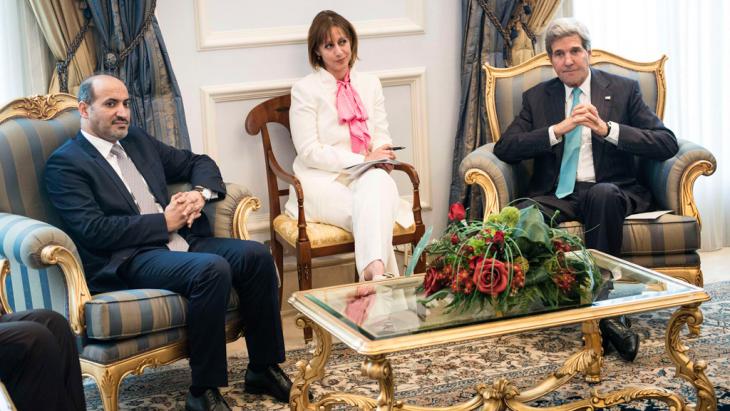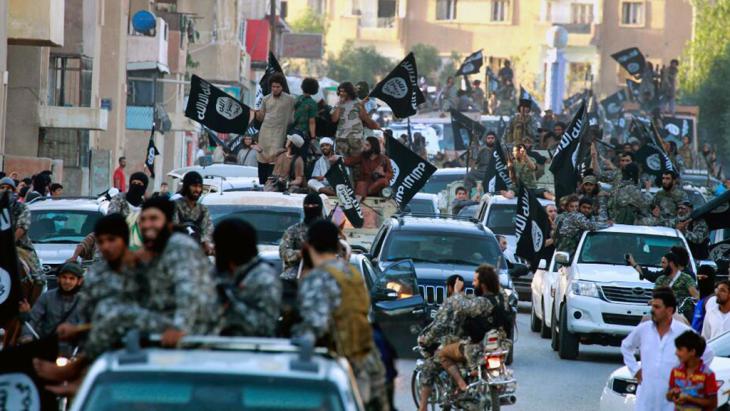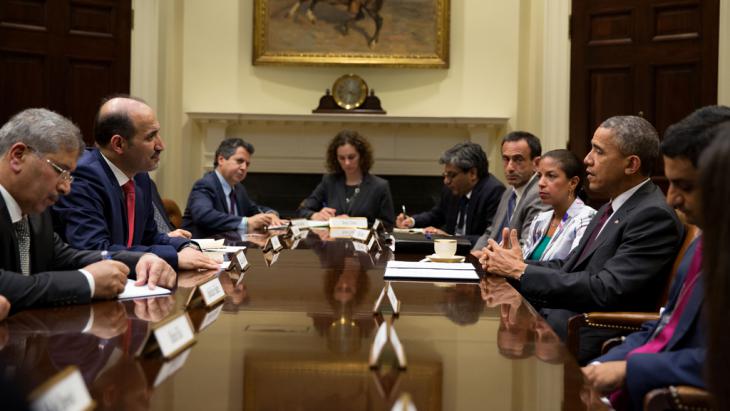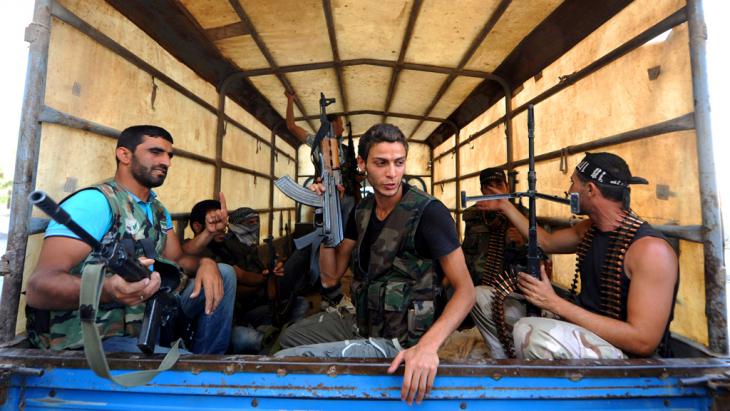Wanted: moderate, reliable rebels for fight against IS

It all sounds so simple. The US bombards IS from the air while local rebels fight it on the ground. This strategy is currently working to a certain extent with the Kurdish Peshmerga in northern Iraq, and Obama now wants to try it in Syria. But who is the West supposed to co-operate with? Who are these "moderate rebels" we keep hearing so much about?
The search for partners in Syria is difficult for three reasons. Firstly, the armed opposition in the country is extremely fragmented, and changing alliances make it difficult to determine with whom each individual brigade is allied. Secondly, after a battle for survival lasting three years, the resistance against the Assad regime has been Islamised across the board, among other things because it was largely financed by Saudi Arabia, Qatar and Turkey. And thirdly, the US and their key allies in the region (the very three countries mentioned above) cannot agree on which groups to support because they have very different ideas about how the Syria of the future should look.
Huge numbers of rebel groups
To the first problem: the CIA says there are 1,500 militia groups in Syria. To categorise them even roughly requires considerable simplification. Most of the brigades consist of a few hundred or a few thousand fighters and are led by local figures who attach importance to their independence and their local support. It is often the case that when groups merge under a new flag (whether geographical or concept-based), the alliance often only lasts a few months or gets no further than online declarations of intent.
The ideological spectrum of rebel groups ranges from secular-nationalistic through conservative-Islamic to Salafi-jihadist, with blurred dividing lines between the groups. Groups that are nationally disposed and that employ non-religious arguments include the loosely affiliated FSA and the Kurdish People's Protection Units (YPG), the military wing of the Syrian PKK sister party the Democratic Union Party (PYD). FSA units dominate the fight in the north-western province of Idlib, where supplies come in via Turkey. They are fighting in and around Aleppo, in the south of the country near Daraa and in Greater Damascus. The YPG controls the Kurdish north-eastern part of the country.
The Islamic midfield is led by the Islamic Front (IF), the most powerful rebel alliance in Syria with an estimated 50,000 fighters nationwide. Their members all use religious rhetoric, but while some of them represent more radical Salafist positions, some uphold democratic principles and the rights of women and minorities. Originally, there were seven founding groups of IF in November 2013 including Ahrar al-Sham (northern Syria), Liwa al-Tawhid (Aleppo), Suqour al-Sham (Idlib) and Jaish al-Islam (Damascus).

Fragmented opposition
The attack in early September on the leadership of Ahrar al-Sham, one of the most important groups, which killed not only the IF's political mastermind Hassan Aboud but also the entire leadership cadre of Ahrar al-Sham, could weaken the Islamic Front. Decisive for development in the coming months will be whether fighters from Ahrar al-Sham (of whom there are about 20,000) will defect to the FSA or to the radicals, perhaps even to Islamic State.
The latter obviously belongs to the jihadist end of the spectrum, as does the Nusra Front, the official al-Qaida offshoot in Syria, as well as various foreign groups. These consist of non-Syrian jihadis, who are just making a stopover in Syria on their way to establishing a global caliphate and who often organise themselves according to their nationalities, among them Tunisians, Egyptians, Libyans, Moroccans, Lebanese, Saudis, Uzbeks, Chechens and a number of former Guantanamo detainees.
While the foreign groups of jihadis all support Islamic State at least ideologically, the Nusra Front is bitterly opposed to it. The reason being that when IS leader Abu Bakr al-Baghdadi tried to establish himself as the only al-Qaida representative for Iraq and Syria and the Nusra Front refused to play ball, Baghdadi and his followers broke with al-Qaida. Since then, Baghdadi has been implementing his own plan for a caliphate and is being fought in Syria by all other rebels, i.e. the FSA, the Kurdish YPG, the Islamic Front, and the Nusra Front.
Shifting alliances
Because the many brigades can achieve little alone, they join forces for larger-scale campaigns, whether it be to capture a military airfield belonging to the regime or to drive IS out of a particular region. New local alliances pop up all the time. FSA and Islamic Front units regularly work together in these endeavours, and in the past, the well-equipped Nusra Front often joined in. As a consequence, fears that weapons might end up with al-Qaida are entirely plausible.
So who should get the US$500 million proposed by Obama? Up to now, the Americans have primarily worked together with the FSA. The attempt to bring some structure to the battle against Assad, via the Supreme Military Council founded in 2012 (the military partner of the political opposition abroad, the National Coalition), is considered to have failed, primarily because the US has promised a great deal and fulfilled very few of these pledges. This is why most of the brigades have started selecting their foreign supporters themselves.
In the meantime, it is thought that the CIA finances 12 to 14 militias in the north and some 60 smaller groups in the south of the country, but can the US win the battle against IS with the FSA alone? Must the West not consider involving the nation's most powerful brigades, which include many Islamic Front fighters?

The islamisation of the rebellion
This brings us to problem number two, the Islamisation of the rebellion. Of course, the pamphlets and websites of many IF organisations sound radical to our ears, but we must be cautious with ideological categorisations, particularly within the broad midfield of the Syrian resistance. The ideology put on show is currently aimed at financing the struggle and is less an expression of steadfast political conviction. Because the most important donors have for years been located in the Gulf, black-and-white headbands bearing an avowal to the Islamic faith are worth more than camouflage gear.
In actual fact, Syria's rebels are very open to ideological influences. Depending on who is sitting opposite them – a Western secret service agent or an envoy of the Saudi King – they profess to wanting democracy and freedom for all, or say they are striving to establish a Sunni theocracy. They are also correspondingly flexible in the daily battle for survival.
Anyone who doesn't get as much as a Kalashnikov from the FSA prefers to go to the Islamists of Ahrar al-Sham, who are much better equipped. If a young man needs to support his extended family, he will quickly defect to IS, which pays a good wage. But that doesn't necessarily mean he has become a die-hard jihadi overnight. In short, there is a huge pool of volunteer Syrian fighters that the West can draw on using financial incentives.
But caution is needed: anyone demanding an immediate renunciation of Islamist positions as a prerequisite for arms shipments risks leaving rebel leaders looking like corrupted stooges of the West and losing fighters to more radical groups. The Americans and Europeans can prevent this own goal by initially making individual brigades powerful and independent of jihadi support. Anyone who earns more money with the FSA than with IS, will remain loyal to the former. And anyone who can capture one of Assad's military bases with their own resources does not need to fall back on the Nusra Front. Loyalty must be worthwhile.
In the case of the Nusra Front in particular, a group that almost all Syrian rebel organisations have fought with at one time or another, the following applies: it would be better not to confront it directly (or else it will soon seal allegiances with IS again), but rather to slowly pull the rug out from under its feet. Last July, eight brigades – all of them recipients of Western military aid – announced they would no longer be working with the Nusra Front. However, at least one of them then fought alongside Nusra to defend Aleppo, because they did not have access to the modern weapons required.

Drawing the line at jihadis
And so we're left with problem number three, the differing ideas about how Syria will look in the future. While the West dreams of a preferably secular, democratic state based on the rule of law, Saudi Arabia would prefer to see a Sunni theocracy, while Qatar would like to see a victory by the Muslim Brotherhood.
But because the Gulf States, unlike the US, are not prepared to deploy their armies, which are highly modern thanks to German arms exports, in Syria, Washington must be allowed to select its allies on the ground. The Saudis and Qataris can pay, and the Jordanians and Turks and provide logistical support, but the last word on who receives Western help must lie with those who are taking the greatest risk, and so far this would appear to be the US.
In its search for allies in Syria, the West should draw the line at co-operating with the jihadis, but not overrate the Islamist professions of Syrian brigades. It should reward the new co-operation between the FSA and the YPG and standardise structures by supplying modern weaponry to the FSA, the Kurds and as many units of the Islamic Front as possible, thereby binding these groups to the US and isolating and weakening radical groups like the Nusra Front. And most importantly: it should stop making promises it cannot keep.
Kristin Helberg
© Qantara.de 2014
Translated from the German by Nina Coon and Aingeal Flanagan